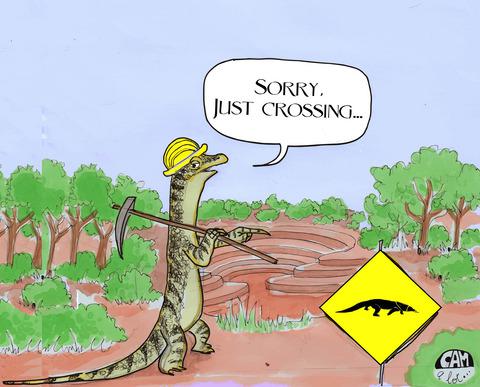当前位置:
X-MOL 学术
›
Austral Ecol.
›
论文详情
Our official English website, www.x-mol.net, welcomes your feedback! (Note: you will need to create a separate account there.)
Using monitors to monitor ecological restoration: Presence may not indicate persistence
Austral Ecology ( IF 1.5 ) Pub Date : 2020-05-22 , DOI: 10.1111/aec.12905 Sophie L. Cross 1 , Michael D. Craig 2, 3 , Sean Tomlinson 1 , Kingsley W. Dixon 1 , Philip W. Bateman 4
Austral Ecology ( IF 1.5 ) Pub Date : 2020-05-22 , DOI: 10.1111/aec.12905 Sophie L. Cross 1 , Michael D. Craig 2, 3 , Sean Tomlinson 1 , Kingsley W. Dixon 1 , Philip W. Bateman 4
Affiliation

|
Habitat loss is a leading cause of biodiversity declines globally, and there has been increasing recognition in recent years of the importance of restoring degraded habitats to functional ecosystems to ameliorate this loss. Despite the critical roles animals play in ecosystems, animals are often overlooked in assessments of ecological restoration success, particularly beyond their presence or absence in these habitats. Apex predators are critical to ecosystems, regulating predator–prey dynamics, and in arid Australia, monitor lizards (Reptilia: Varanidae) often fill high‐order predatory roles. Varanids are highly diverse in size and occupy a variety of ecological niches, providing an ideal group for assessing habitat change over multiple spatial scales. Here, we assess the responses of varanids to early‐stage habitat restoration following the discontinuation of mining activities, by mapping behavioural signs of habitat usage including burrows, tracks and diggings. We recorded burrow size and track measurements to gauge the size of varanids utilising reference and restored habitats, and mapped tortuosity of tracks to assess their movement through habitats. Restored areas had significantly fewer signs of varanid presence than the reference bushland and largely appeared to be just traversed or used only by larger individuals. Restored landscapes, particularly those in early successional stages, often lack established vegetation cover and present increased metabolic costs and predation risks. Providing fauna refuges (e.g. hollow logs) to mitigate the metabolic costs and predation risks in areas undergoing restoration may aid in facilitating the return of varanids and of other animal populations, particularly during the early stages of vegetation establishment. Understanding the behavioural responses and movement ecology of animals within landscapes undergoing restoration is key to facilitating the conservation of self‐sustaining and functional ecosystems.
中文翻译:

使用监测器监测生态恢复:存在并不代表持久性
栖息地丧失是全球生物多样性下降的主要原因,近年来人们越来越认识到将退化的栖息地恢复到功能生态系统以改善这种丧失的重要性。尽管动物在生态系统中发挥着关键作用,但在评估生态恢复成功率时,动物往往被忽视,尤其是在这些栖息地存在或不存在的情况下。顶端捕食者对生态系统至关重要,调节捕食者-猎物动态,在干旱的澳大利亚,蜥蜴(爬行动物:巨蜥科)通常扮演高级捕食者的角色。Varanids 的大小高度多样化,占据各种生态位,为评估多个空间尺度的栖息地变化提供了理想的群体。这里,我们通过绘制栖息地使用的行为迹象(包括洞穴、轨道和挖掘)来评估 varanids 对采矿活动停止后早期栖息地恢复的反应。我们记录了洞穴大小和轨迹测量值,以利用参考和恢复的栖息地来衡量 varanids 的大小,并绘制轨迹的曲折度以评估它们在栖息地中的移动。与参考丛林相比,恢复区域的瓦拉尼虫存在迹象明显更少,而且在很大程度上似乎只是由较大的个体穿过或使用。恢复后的景观,尤其是早期演替阶段的景观,通常缺乏成熟的植被覆盖,并且会增加代谢成本和捕食风险。提供动物保护区(例如 空心原木)以减轻正在恢复的地区的代谢成本和捕食风险,可能有助于促进 varanid 和其他动物种群的返回,尤其是在植被建立的早期阶段。了解正在恢复的景观中动物的行为反应和运动生态是促进自我维持和功能生态系统保护的关键。
更新日期:2020-05-22
中文翻译:

使用监测器监测生态恢复:存在并不代表持久性
栖息地丧失是全球生物多样性下降的主要原因,近年来人们越来越认识到将退化的栖息地恢复到功能生态系统以改善这种丧失的重要性。尽管动物在生态系统中发挥着关键作用,但在评估生态恢复成功率时,动物往往被忽视,尤其是在这些栖息地存在或不存在的情况下。顶端捕食者对生态系统至关重要,调节捕食者-猎物动态,在干旱的澳大利亚,蜥蜴(爬行动物:巨蜥科)通常扮演高级捕食者的角色。Varanids 的大小高度多样化,占据各种生态位,为评估多个空间尺度的栖息地变化提供了理想的群体。这里,我们通过绘制栖息地使用的行为迹象(包括洞穴、轨道和挖掘)来评估 varanids 对采矿活动停止后早期栖息地恢复的反应。我们记录了洞穴大小和轨迹测量值,以利用参考和恢复的栖息地来衡量 varanids 的大小,并绘制轨迹的曲折度以评估它们在栖息地中的移动。与参考丛林相比,恢复区域的瓦拉尼虫存在迹象明显更少,而且在很大程度上似乎只是由较大的个体穿过或使用。恢复后的景观,尤其是早期演替阶段的景观,通常缺乏成熟的植被覆盖,并且会增加代谢成本和捕食风险。提供动物保护区(例如 空心原木)以减轻正在恢复的地区的代谢成本和捕食风险,可能有助于促进 varanid 和其他动物种群的返回,尤其是在植被建立的早期阶段。了解正在恢复的景观中动物的行为反应和运动生态是促进自我维持和功能生态系统保护的关键。


























 京公网安备 11010802027423号
京公网安备 11010802027423号